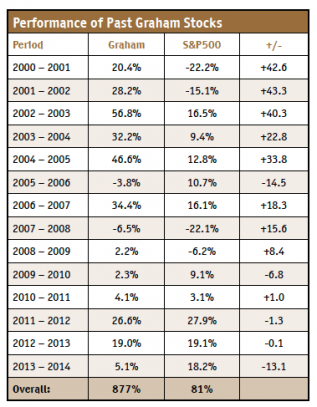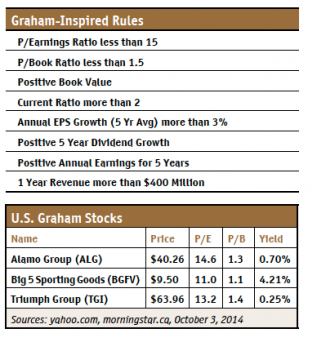Three Graham Stocks For 2015
 Each fall I like to look for companies that pass my take on Benjamin Graham's test for defensive investors, which generally leads to stable firms trading at bargain prices.
Each fall I like to look for companies that pass my take on Benjamin Graham's test for defensive investors, which generally leads to stable firms trading at bargain prices.
I started hunting for Graham stocks way back in 2001 and, so far, they've fared better than my wildest expectations. If you had purchased equal dollar amounts of the Graham stocks and replaced them with the new batch each year, your portfolio would be up a whopping 877% (18% annualized) over the full period. On the other hand, index investors who bought and held the S&P500 ETF (NYSE:SPY) only gained 81% (4% annualized) over the same time period.
However, the Graham stocks don't outperform each and every year. Last year they advanced only 5% and trailed the market which gained 18%. You can examine the full performance record in the accompanying table.
(The returns figures mentioned above are provided in U.S. dollar terms and include dividends that are reinvested each year when the new stocks are selected.)
Mr. Graham's original method for defensive investors is described in his book The Intelligent Investor, which should be on every investor's bookshelf. While the book is a little dated, a new edition (ISBN 0060555661) was published in 2003 with modern commentary from veteran columnist Jason Zweig. Serious Graham buffs should also invest in a copy of the sixth edition of Security Analysis (ISBN 0071592539), which includes commentary from some of today’s most famous value investors. However, the second volume can be a little daunting for new investors.
Mr. Graham’s original rules for defensive investors were very strict. So strict in fact that you wouldn't have found any North American stocks using them for most of the last two decades. That's why my version employs a slightly more lenient approach. The main criteria that I use are summarized in the accompanying table.
For instance, I differ with Mr. Graham when it comes to dividends. He originally demanded a twenty-year record of uninterrupted dividend payments whereas I require only some dividend growth over the last five years.
Even with the slightly more lenient requirements, very few U.S. stocks usually pass muster. At market lows, such as those seen in the spring of 2009, dozens of defensive stocks are often available. But in more normal times less than 10 companies usually make the grade each year. This time around only three passed the test and they're highlighted in the accompanying table.
It is important to be aware that a well-diversified portfolio should hold more than 10 stocks and in most cases many more. That's why, if you're keen on this year's defensive stocks then please use them to supplement a diversified portfolio.
As always, before buying any stock it is important to examine it in great detail. After all, the less tangible aspects of each company are well worth considering. You can get up to speed by reading news stories about the company along with its press releases and regulatory filings.
 My take on Graham’s defensive method has avoided serious trouble so far but it can’t be expected to outperform all of the time. After all, despite its excellent long-term track record, it has trailed the market in five of the last fourteen years.
My take on Graham’s defensive method has avoided serious trouble so far but it can’t be expected to outperform all of the time. After all, despite its excellent long-term track record, it has trailed the market in five of the last fourteen years.
It is also important to take your time to get comfortable with the method, and value investing more generally, before diving in. Start off in a small way with a modest amount of capital because sticking with value investing through thick and thin can be harder than many people expect.
Norman Rothery, PhD, CFA, Founder of StingyInvestor.com, Toronto, ON (416) 243-9580, rothery@stingyinvestor.com, www.stingyinvestor.com

